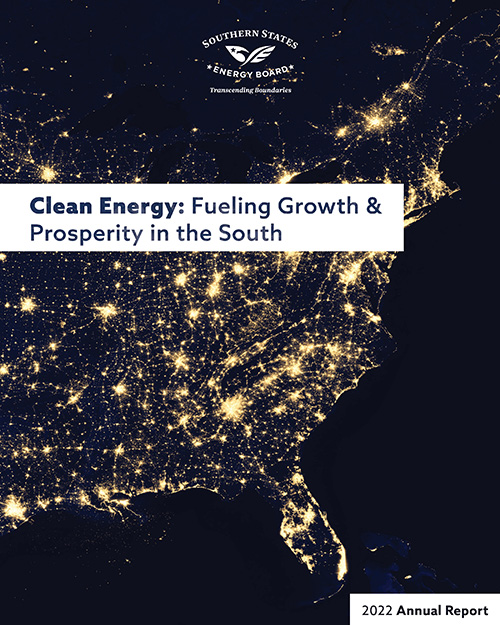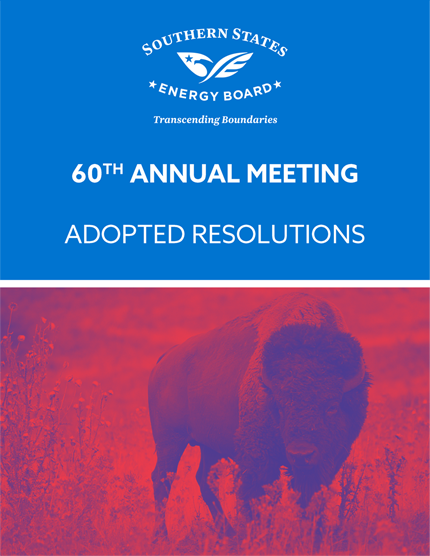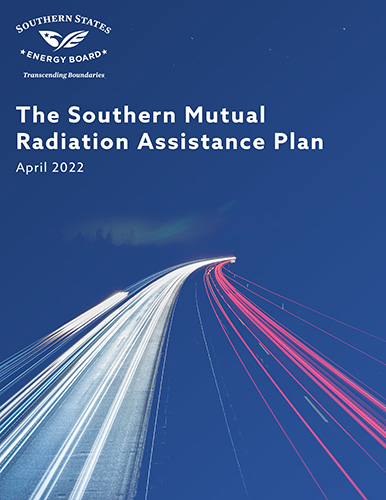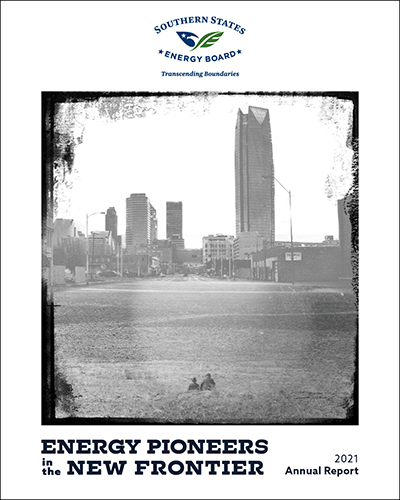Annual Report Now Available
Our 2022 Annual Report is now available! Click the button below to review our activities over the past year. Printed copies of the report will be available at our upcoming 62nd Annual Meeting. You can request a copy via email as well.
Our Chairman’s Message from South Carolina’s Governor Henry McMaster is excerpted below:
It is an honor to serve as the Chairman of the Southern States Energy Board for 2021-2022. This outstanding organization has been a vital catalyst for energy and economic growth in the South during its 62 years in existence. The governors and state legislative leaders who forged this interstate compact in 1960 could not have known that the organization over time would become “the voice of the South to the Administration and Congress on energy and environmental issues.”
This year, I chose, “Clean Energy: Fueling Growth and Prosperity in the South” as our theme. I believe our South Carolina story is typical of our other Southern States. Our economy is booming. More and more people are visiting our state – with many deciding to stay for good. Employers are creating new jobs, entrepreneurs are opening new businesses, and companies are deciding to relocate here. Our business and family-friendly environment has produced historic gains in new jobs, capital investment and population growth.
Also, we are working hard to promote energy innovation. We are making strategic investments in technology, protections against cyber and physical threats, and clean and renewable energy. Our Southern States together boast an eight trillion-dollar economy and utilize more than half of the nation’s energy resources to fuel our industrial production and business development. The unprecedented transition that is underway in the energy sector only adds to the infrastructure challenges which stand before us.
Emerging out of the COVID-19 pandemic of the past two years, our Southern States have led the nation in a resurgence that has expanded job opportunities and economic expectations. South Carolina exemplifies this growth trend as an “all of the above” energy resource State in terms of fuels and uses. We are the third largest producer of nuclear power in the nation. Over the past decade, South Carolina has shifted from the use of coal to natural gas. Although coal still accounts for nearly 13 percent, the use of natural gas has more than doubled, providing about 24 percent of our energy, with nuclear providing 55 percent.
Renewable energy resources also have an exciting future here. Hydropower, solar energy, and biomass now combine to account for 8 percent of electricity generation. We have 122 active solar farms and 33 wind energy manufacturing facilities. Our port facilities in Charleston, Mount Pleasant, and North Charleston provide a U.S. gateway for the global wind energy market, as South Carolina is considered to have the second largest offshore wind resources on the East Coast.
Further, our electricity rates remain low-cost to the consumer, below the national average, making the “Palmetto State” a growing attraction for business and industry. We rank among the “Top 10” states in residential sector per capita electricity sales. Our major industries include motor vehicle manufacturing, chemicals, and paper production, which together account for one-third of the State’s total energy consumption.
So, as you can see, South Carolina’s energy story is a good one. And like those of all of our Southern States, it is going to get even better. This year all of us have seen a major emphasis at federal and state levels focused on energy issues and the environment. These efforts are directed toward an energy transition that accelerates the use of “clean energy,” renewables, decarbonization, carbon capture and storage, grid modernization, emissions mitigation, and a re-emphasis of the transportation sector centered around electric vehicles. On behalf of its member jurisdictions, the Southern States Energy Board has been in the midst of these developments both in the state legislatures and in Washington, D.C., working with Congress and federal agencies.
Our Southern States have strong environmental track records, highly efficient and well-controlled power plants, and we have benefited from consistent improvements in ambient air quality as a result. In our region, ozone levels continue to drop, and electric power is playing an even smaller role with respect to mobile and point source air pollution emissions. Ten of our member states have submitted revised state implementation plans to the U.S. Environmental Protection Agency (EPA) in good faith governing the interstate transport of emissions under the 2015 Ozone National Ambient Air Quality Standard enshrined in the Clean Air Act. Four regional transmission organizations (ERCOT, MISO, PJM, and SPP) have submitted written comments to EPA expressing concerns that the new and pending Regional Transport Rule Federal Implementation Plan will prematurely close critical baseload power plants with no replacement power in place by 2026. This forced retirement of natural gas and coal plants throughout the South will affect reliability, resiliency, and the sustainability of electric power across the region. A measure of “cooperative federalism” is needed here to address these concerns and resolve them early.
An emphasis of the Southern States Energy Board for more than the past two decades has been “Carbon Management.” During its meeting in 2000, members of the Board determined that carbon emissions were an increasing problem in the region and across the nation. They voted to add carbon management to the list of long-term issues that needed to be addressed by the Board and brought to the attention of the federal government. Soon thereafter, President George W. Bush’s Administration proposed a “Clear Skies Initiative” to reduce greenhouse gases which was quickly followed in 2003 by the creation of the international Carbon Sequestration Leadership Forum and Regional Carbon Sequestration Partnerships proposed through the Office of Fossil Energy at the U.S. Department of Energy.
The Southern States Energy Board was chosen to manage the Southeast Regional Carbon Sequestration Partnership (SECARB) focusing initially on carbon dioxide removal from the atmosphere. Southern States Energy Board geologists and partners characterized promising locations in the Southern region, finding many suitable geologic formations for the permanent storage of carbon dioxide emissions. Owing to historical oil and gas exploration, initial efforts identified spectacular carbon dioxide storage potential in the Gulf region of the South. This work continues, with much of the effort focused on characterizing areas with limited existing information to determine suitability for carbon dioxide storage. With a better understanding of the region’s geology, The Southern States Energy Board is assisting governments and industries in finding feasible locations for commercial carbon capture and storage technology deployment in the region.
Small carbon dioxide capture and storage field tests followed the Board’s early successes with the characterization of sources and sinks, proving that carbon dioxide could be managed and stored in deep geologic formations safely and securely. In an ultimate “early test,” the SECARB Partnership injected over 11 million metric tons of carbon dioxide into an oil field in Cranfield, Mississippi. This enormous achievement was followed by another when the SECARB Partnership built the world’s first integrated carbon capture, transportation, injection and storage facility at Plant Barry in Bucks, Alabama, in 2013, demonstrating the viability of carbon capture and storage. The plans for this unit were then utilized by NRG Energy to scale up and construct a commercial sized plant near Houston, Texas.
Ongoing activities in the Board’s SECARB-USA Regional Partnership Initiative include the evaluation of subsurface data density so that our states can better understand their respective carbon dioxide storage potential and identify potential risks to commercial carbon dioxide storage operations. As part of this, the Board and its partners have been drilling stratigraphic test wells in Alabama and Georgia near large volume emitting facilities with promising results for carbon dioxide removal. This will enable states and industry to work together, further de-risking industry investments in carbon capture and storage.
On May 16, 2022, the Board hosted a highly successful, major workshop in New Orleans, providing an opportunity for subject matter experts to meet with state and federal environmental regulators to identify key areas of multi-state and multi-agency collaboration. Regulators from Alabama, Arkansas, Louisiana, Mississippi, and Texas attended to discuss well drilling and design and other aspects of EPA Class VI permitting requirements. In addition to this, the Southern States Energy Board and its many partners have managed over 180 inquiries and instances of knowledge sharing with industries interested in incorporating carbon dioxide capture and storage into their broader decarbonization strategies. As part of this, initial feasibility studies have been developed at the request of the cement and pulp and paper industries. The Southern States Energy Board’s staff expertise and experience have made the organization a premiere knowledge source for industry partners.
The Southern States Energy Board’s CCS Commercialization Consortium, formed with academic partner, The University of Houston, and its Center for Carbon Management in Energy in 2020, is engaging leading industries across the nation to minimize the challenges associated with CCS Commercialization and provide solutions. Currently, more than 50 major domestic and international companies and industries in the fields of oil, natural gas, chemicals, transportation, cement, pulp and paper, research engineering, academic research, geologic storage, CCS drilling and design, and technical project innovation, are members. The Consortium supports the mission of the U.S. Department of Energy to minimize the environmental impacts of fossil fuels while working toward net-zero emissions. In its first year, the Consortium members developed a Roadmap containing the full chain of CCS activities. These include carbon capture, transportation, storage, utilization, policy and regulatory capacities, environmental justice and stakeholder engagement, workforce development, risk reduction, long-term liability, insurance, and financial investment markets. The strategic focus in this second year is on environmental justice and stakeholder engagement; policy, legal and regulatory matters; and commercialization enablers such as risk management, liability, and financial markets.
The Board is also working on developing a technology that can capture carbon dioxide directly from the air. This technology, commonly referred to as direct air capture (DAC), removes many of the spatial limitations of existing technologies and opens the possibility of capturing carbon dioxide anywhere in the world. In a cooperative agreement with the U.S. Department of Energy, the Southern States Energy Board is leading a public-private partnership with companies and utilities across the nation to build a direct air capture unit that can capture carbon dioxide from utilities or industrial emitters. The test unit will be constructed during the fall and winter months of 2022 for demonstration and testing at the National Carbon Capture Center in Wilsonville, Alabama, in 2023.
As part of its ongoing federally funded Project ECO2S, the Southern States Energy Board and its 19 partners have collaborated with site host Mississippi Power Company and drilled six new characterization wells and acquired 92 linear miles of 2D seismic data in Kemper County, Mississippi. Here the goal is to identify and characterize are carbon dioxide storage complex capable of storing 50 million metric tons of carbon dioxide over a 30-year period. Reservoir models indicate that the subsurface of eastern Mississippi represents a world class prospect with an estimated storage capacity of almost one billion metric tons of carbon dioxide.
Rounding out the Board’s Carbon Management Program is the SECARB Offshore Partnership. The Southern States Energy Board and its partners are focused on evaluating the potential for carbon dioxide storage in the Eastern Gulf of Mexico. The project includes an analysis of existing and required legal and regulatory frameworks in anticipation of commercial deployment. The Board and its partners are assessing storage location opportunities, and identifying risks associated with legacy infrastructure, geology, business case models, and regulations to assist industry. Active participation includes state regulators from Alabama, Louisiana, Mississippi, and Texas.
In the third year of a five-year project, our Transuranic Waste Transportation Working Group is comprised of state officials named by their governors who coordinate the interstate transport of TRU waste to the Waste Isolation Pilot Plant in Carlsbad, New Mexico. This project also enables the Southern States Energy Board to provide direct funding to states to support staff who monitor these shipments, engage in emergency response planning and first responder training. The funds provided by the Southern States Energy Board allow corridor states to purchase special equipment, and communication devices unique to this field.
Our Radioactive Materials Transportation Committee meets twice annually with officials from the U.S. Department of Energy to stay abreast of nuclear waste shipments in various categories and special developments requiring state assistance in transit. State officials are funded through the Southern States Energy Board, participate in technical training, and learn from experts regarding the treatment of waste materials, and other nuclear issues such as casks for nuclear spent fuel, interim storage, consent-based siting, and new, small modular reactors that may be deployed in the future.
Paramount to the Board’s success is the valuable contribution that we receive each year from our industry Associate Members. Many participate as technical advisers and consultants on the Southern States Energy Board projects and work with staff to add their expertise on critical energy or environmental topics of interest. Our Associate Members provide us with the ultimate public-private partnership and for this I am most grateful.
The Southern States Energy Board remains a cutting edge, policy and technology organization providing an experienced technical staff of innovators and experts who are constantly at work for member states and territories. Current programs and projects of the Board bring in almost one-half billion dollars to the states in our Southern region. I commend this 62nd Annual Report of the Board to all members and interested parties, signifying a proud tradition of leadership that has continued to evolve over many decades!
His Excellency Henry McMaster
Governor of South Carolina
Chairman




